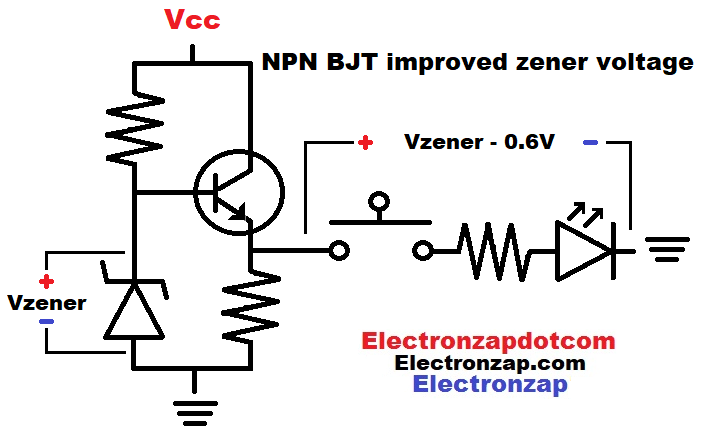Table of Contents
Zener diodes are most effective when there is a steady current through them. If a load at the output needs current, then it will alter the zener voltage, at least a little. It is best to only use the zener output as a signal that other circuitry responds to.

- The NPN Bipolar Junction Transistor (BJT) wired as an emitter follower will output 0.6V less than the voltage at it’s base. Emitter followers have the load on the emitter side of the BJT.
Very little current is needed from the base in order to tell the transistor what voltage to set at the emitter. Therefore, the base voltage will stay basically the same, unless it is a very weak signal.
- To get the emitter to output the actual zener diode voltage, you can put a forward biased silicon based rectifier diode in series with the zener diode. That is stacking voltage drops.
Doing so will raise the base voltage at the diode output by approx. 0.6. Compensating for the 0.6V base to emitter voltage drop.
Some loads may throw off the emitter voltage of an NPN follower by themselves. So, by adding a resistor from emitter to ground, helps the emitter maintain the base minus 0.6V voltage in relationship to ground.
Brief Circuit Schematics with Short Video List of Pages
Remember that you always need a higher supply voltage (Vcc) than the base voltage. You must do so in order to make sure that current flows through the zener diode (plus rectifier diode in this example), and whatever is setting the current through it.
Usually a supply voltage that is 2 volts, or more, higher than the zener voltage will be enough.
The supply voltage can of course be much higher than that. The emitter output voltage will be almost exactly the same regardless of the supply voltage. The main limiting factor to supply voltage is the power rating of each component based on the voltage(s) across them, and the total current flowing through them.
The BJT has collector to emitter voltage and current, while it also has a base to emitter voltage and current. The base to emitter current is almost always low enough that it doesn’t hardly factor into how much heat is produced, but it is something to keep in mind if you already know that the collector to emitter power will already be bringing the NPN BJT close to it’s maximum power rating.
Video:
LED load:

Video:
Brief Circuit Schematics with Short Video List of Pages
To support this site, check out the following links:
Affiliate link ad of the portable power supply used in my videos. There are larger ones that are cheaper if portability isn’t important. I primarily got this one because I can easily film it next to my circuits while making my YouTube videos.
- Become a Patron!
- Check out my YouTube videos! https://www.youtube.com/c/Electronzap/videos
- Products I used in my videos or otherwise think look like a good buy. As an Amazon associate, I earn from qualifying purchases. https://www.amazon.com/shop/electronzapdotcom
- Information on this site is not guaranteed to be accurate. Always consult the manufacturer info/datasheet of parts you use. Research the proper safety precautions for everything you do.
- Electronzap is a participant in the Amazon Services LLC Associates Program, an affiliate advertising program designed to provide a means for sites to earn advertising fees by advertising and linking to amazon.com.